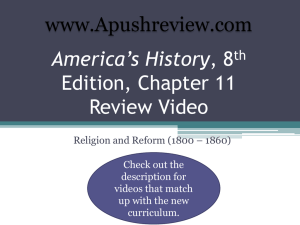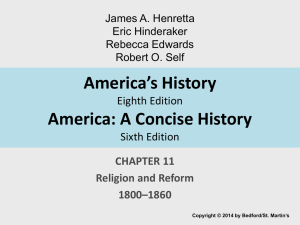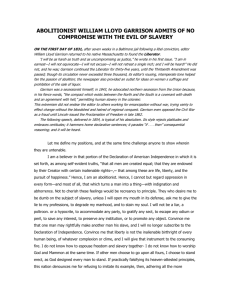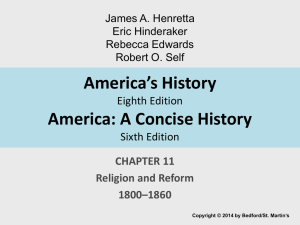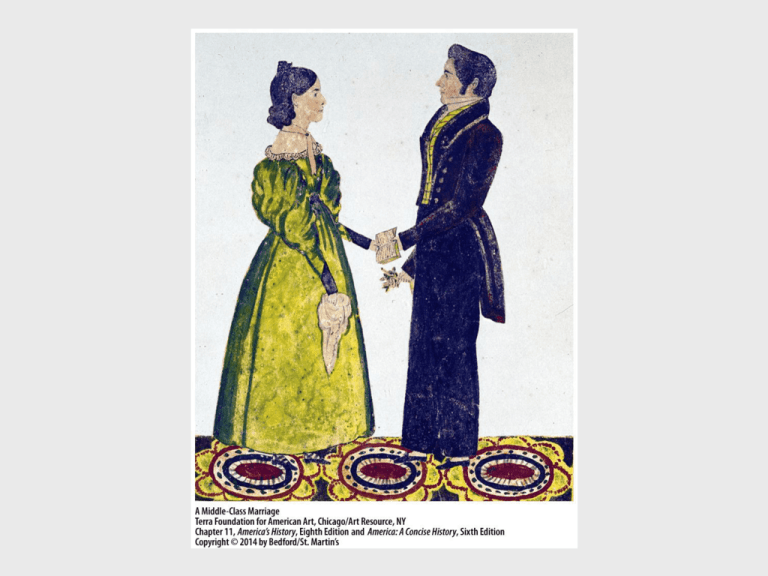
I. Individualism: The Ethic of the Middle Class
A. Ralph Waldo Emerson and Transcendentalism
1. Transcendentalism
a) Intellectual movement rooted in Unitarianism (God is single
being
b) Rejected Enlightenment idea-celebration of human
passions and mysteries, individuality
c) Emerson-moved to Concord, MA, resigned from a
ministerial position in Boston
d) people trapped by traditions
e) ideal setting for transcendent discovery was under an open
sky, in solitary communion with nature; work was
destroying spiritual lives.
2. The lyceum movement
• Beginning in 1826, the movement was a way to
reach people through public lectures,
discussions
• modeled after Aristotle’s public lectures in
ancient Greece
• Attractive to the middle class in the North and
the Midwest, not the South; Massachusetts had
more than 150 lyceums in 1839
• Emerson was the most popular speaker.
I. Individualism: The Ethic of the Middle Class
B. Emerson’s Literary Influence
1. Thoreau, Fuller, and Whitman
a) Henry David Thoreau: built cabin at Walden Pond after his
brother’s death, lived there for 2 years alone, and published
Walden, or Life in the Woods about his search for meaning
in the natural world
b) Margaret Fuller: explored freedom for women, edited The
Dial (transcendentalist journal) and published Woman in
the Nineteenth Century (1844); men and women were
capable of a relationship with God; women deserved
independence; literary critic for New York Tribune
c) Walt Whitman: printer, teacher, journalist, and newspaper
editor; published Leaves of Grass (1855) as a collection of
poetry celebrating the desire to break from tradition.
2. Darker Visions
• Nathaniel Hawthorne: pessimistic worldview,
published The Scarlet Letter (1850) criticizing
excessive individualism
• Herman Melville: critic of transcendentalist
focus on the individual, published Moby Dick
(1851) in which a personal quest brings death.
II. Rural Communalism and Urban Popular Culture
A. The Utopian Impulse
1. Mother Ann and the Shakers
a) 1774, Lee Ann Stanley (Mother Ann) founded the Shakers1st successful American communal movement
b) 1770, vision of herself as Christ on earth
a)
believed sexual lust had been the downfall of Adam and Eve
c) known as “Shakers” for dancing during service
d) Mother Ann died in 1784
e) 20 more communities in New England, New York,
and Ohio to celebrate her.
f) Increased numbers through orphans, adoptions
g) by 1900, they virtually disappeared, leaving their
legacy of simple and beautiful furniture.
2. Albert Brisbane and Fourierism
• Charles Fourier predicted imminent decline of
individual property rights and capitalist values,
Brisbane was leading disciple
• Fourierist socialism would liberate workers from
capitalist employers
• Phalanxes (members of the community) would own
property in common, liberation of women as well as
men.
• 1840s, Fourierists founded one hundred cooperative
communities in western New York and the Midwest;
collapsed over conflicts about work responsibilities
and social policies, no utopian societies without great
leaders or religious visions
II. Rural Communalism and Urban Popular Culture
A. The Utopian Impulse (cont.)
3. John Humphrey Noyes and Oneida
a) Noyes was both charismatic and religious
a) No marriage (major barrier to sinless perfection on earth,
“complex marriage” in which all members of community are
married to one another
b) Rejected monogamy to free women from their status as
husbands’ property; female followers cut their hair short and
wore pantaloons
c) 1848, Noyes founded community near Oneida, New York
d) manipulated the sexual lives of his followers.
e) mid-1850s, two hundred residents and used profits from
steel animal trap manufacturing to diversify into silverware
production
f) Noyes fled to Canada to avoid prosecution for adultery;
community abandoned complex marriage but retained its
cooperative spirit.
II. Rural Communalism and Urban Popular Culture
B. Joseph Smith and the Mormon Experience
1. Joseph Smith
a) Raised in central New York (1805–1844)
b) believed that he had been chosen to receive a revelation
c) published The Book of Mormon (1830) telling the story of an
ancient civilization that migrated to the West and was visited by
Jesus Christ after the Resurrection
d) encouraged patriarchal authority, frugality, hard work, a
church-directed society, moral perfection
e) struggled to find a home for his church where it would not face
harassment
f) eventually settled in Illinois
g) argued that a revelation to him had justified polygamy
h) charged with treason in 1844 when it was believed he was
conspiring to build a community in Mexico; murdered in jail along
with his brother.
2. Brigham Young and Utah
a) Led Smith’s disciples
b) about 6,500 Mormons fled the U.S. for Mexico
after his death
c) eventually settled in the Great Salt Lake Valley
d) created a planned agricultural community
e) named Young as governor when Utah became
part of the U.S. in 1850
f) led to a short “Mormon War” over the issue of
polygamy and possible nullification
g) those who accepted federal authority would not
be prosecuted for polygamy (banned finally in
1896).
II. Rural Communalism and Urban Popular Culture
C. Urban Popular Culture
1. Sex in the City
a) Population causes new culture in cities, left
rural areas and life in cities was difficult
b) Low wages in factories (MEN), Women worked
in domestics, high rates of Quid Pro Quo
(sexual exploitation), prostitution
c) Married Men have mistresses, brothels
d) sexual identity was experimented with in
the cities without parents having control
over young peoples’ daily lives.
2. Minstrelsy
2. Minstrelsy
a) Rat and terrier fights in traditional theaters
b) Minstrel shows in which white actors performed in
blackface
c) historians have labeled these shows both racist
caricature and social criticism
d) began around 1830; John Dartmouth Rice’s
character “Jim Crow” was famous in New York
City
e) minstrels also stereotyped Irish immigrants’
drinking of alcohol, and made fun of women’s
rights activists and elite white men.
3. Immigrant Masses and
Nativist Reaction
a) Immigrants wanted to be viewed as
“white”
b) Irish joined American Catholic Churches
and became part of the Democratic Party
c) nativists wanted to stop immigration
d) Gangs formed in New York City, and
violence erupted between immigrant
groups and native-born white Americans.
III. Abolitionism
A. Black Social Thought: Uplift, Race Equality, and Rebellion
1. David Walker’s Appeal
a) Northern free blacks-social uplift, white mobs attacked
blacks in northern cities
b) Walker’s writing was in response to attacks. Walker was a
free black from North Carolina who had moved to Boston,
self-educated, ridiculed religious arguments of
slaveholders, justified slave rebellion, and warned of a
slave revolt if blacks were denied justice much longer.
c) 1830, called a national convention of free black leaders in
Philadelphia, group demanded freedom and “race equality”
but refused to endorse Walker’s radical call for revolt or the
traditional program of black uplift.
2. Nat Turner’s Revolt
• Turner, a slave in Virginia who taught himself to
read, was separated from wife by a new master
and had a religious vision; in August 1831, led a
revolt with relatives and friends; killed 55 whites;
he was eventually caught and hanged. The
Virginia assembly increased slave codes,
prohibited anyone from teaching slaves to read,
and limited movement of black people in the
state.
III. Abolitionism
B. Evangelical Abolitionism
1. William Lloyd Garrison, Theodore Weld, and Angelina
and Sarah Grimké
a) Garrison, a printer in Massachusetts, founded the New
England Anti-Slavery Society and published The
Liberator, later established American Anti-Slavery
Society with Weld and other abolitionists; appealed to
religious people
b) Weld published The Bible Against Slavery (1837)
c) Grimké sisters were raised in South Carolina,
converted to Quakerism, and moved to Pennsylvania;
with Weld, the sisters published American Slavery as It
Is: Testimony of a Thousand Witnesses (1839), which
sold more than 100,000 copies that year.
2. The American Anti-Slavery Society
• Printed thousands of pamphlets using steampowered presses
• “great postal campaign” (1835) sent more than
a million pamphlets
• utilized fugitive slaves to tell their stories
• established the Underground Railroad to help
fugitives
• petitioned Congress (1835) to demand abolition
in the District of Columbia, end interstate slave
trade, and prohibit new slave states.
III. Abolitionism
C. Opposition and Internal Conflict
1. Attacks on Abolitionism
a) Movement was a minority (about 10 percent of northerners
supported)
b) slaveholders opposed/attacked the movement for political,
social, and economic reasons
c) white men and women almost universally opposed
“amalgamation,” racial mixing/intermarriage.
d) whites in the North attacked churches, temperance halls,
homes, and conventions of abolitionists
e) race solidarity was stronger in the South but existed in the
North as well.
f) In 1836, Congress passed the “gag rule” to keep abolitionists
from petitioning; remained in place until 1844.
2. Internal Divisions
a) Within the movement, activists disagreed
b) some were critical of women addressing mixgendered audiences and of Garrison’s support
for women’s rights
c) Garrison’s opponents founded a new
organization, the American and Foreign AntiSlavery Society.
IV. The Women’s Rights Movement
A. Origins of the Women’s Movement
1.
Moral Reform
a) Religious women wanted to help other women
b) middle-class women in New York City founded the Female Moral
Reform Society to curb prostitution and to protect single women
from moral corruption
c) members visited brothels, prayed, and sang hymns.
2. Improving Prisons, Creating Asylums, Expanding Education
a) Dorothea Dix (1801–1887) was emotionally abused by an
alcoholic father in Massachusetts, save children from vice;
published author
b) 1841, began a campaign to improve care for the mentally ill
started asylum-building movement to separate the mentally ill
from criminals
c) women supported school movement of Horace Mann in
Massachusetts; recruited well-educated women to be teachers.
IV. The Women’s Rights Movement
B. From Black Rights to Women’s Rights
1. Abolitionist Women
a) Women were central to antislavery movement
b) Harriet Jacobs wrote Incidents in the Life of a Slave Girl,
describing forced sexual relations with her master
c) Harriet Beecher Stowe in Uncle Tom’s Cabin pinpointed
sexual abuse of women as profound moral failing of slavery
d) African American lecturer Maria Stewart spoke about
slavery to mixed audiences first in Boston
e) Angelia and Sarah Grimké attacked slavery and argued
that women have a claim to equal civic rights.
f) 1840, abolitionist women asserted that traditional gender
roles resulted in the domestic slavery of women.
2. Seneca Falls and Beyond
a) 1840’s, strong reform movement for women’s rights including
property ownership, which Mississippi, Maine,
Massachusetts, and New York adopted between 1839 and
1845.
b) Elizabeth Cady Stanton and Lucretia Mott
organized Seneca Falls Convention
a) 70 women and 30 men attended
b) issued “Declaration of Sentiments”
c) claim for women in public life and criticized the idea of
“separate spheres” (women should remain in the
private/home as mothers and wives)
d) 1851, began an effort to gain voting rights; Susan B.
Anthony (1820–1906), a Quaker who argued against
women’s dependence on men, led the campaign for
voting rights at mid-century.


